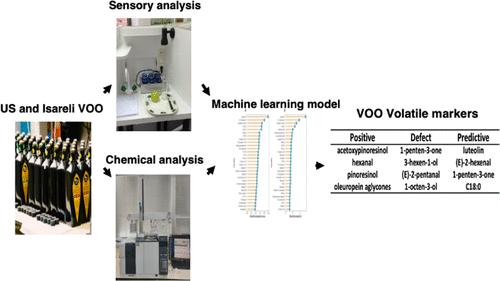美国和以色列初榨橄榄油的化学成分与感官特性之间的关系:缺陷预测模型的开发
IF 5.7
1区 农林科学
Q1 AGRICULTURE, MULTIDISCIPLINARY
引用次数: 0
摘要
初榨橄榄油(VOO)的质量是由化学和感官参数共同决定的。化学参数是客观的,使用仪器方法进行测量,而感官质量评估则以人的品鉴小组为基础,人的品鉴小组可能是主观的,重复性较差,容易疲劳,并且需要长时间和高成本的培训。训练有素的评审团可以最大限度地减少品尝偏差,但使用人类作为测试工具不可避免地会出现各种心理偏差、刺激相关因素和带入效应。本研究的目标是评估可协助现有人类小组评估梵净山酪脂油感官特性的工具方法,并利用来自美国和以色列的梵净山酪脂油样本开发基于化学的感官特性预测模型。我们的研究结果表明,油脂酸败与化学成分含量高度相关;1-戊烯-3-酮、3-己烯-1-醇、(E)-2-戊醛和 1-辛烯-3-醇是与酸败缺陷相关的主要挥发物(这些化合物的浓度较低)。果味等积极的感官属性与 1- 乙酰氧基松脂醇和己醛相关,而苦味则与松脂醇、油菜素苷元的醛形式和油菜素苷元的二醛形式相关。随机森林模型表明,木犀草素、(E)-2-己烯醛、1-戊烯-3-酮和 C18:0 是预测橄榄油样本中出现感官缺陷最有用的测量值。换句话说,当这些化合物低于或高于某个阈值时,感官评定小组就更有可能发现酸败等缺陷。本文章由计算机程序翻译,如有差异,请以英文原文为准。

Relationships Between Chemical Compounds and Sensory Properties of Virgin Olive Oil in the US and Israel: Development of a Prediction Model for Defects
Virgin olive oil (VOO) quality is defined by both chemical and sensory parameters. While the chemical parameters are objective and measured using instrument-based methods, sensory quality evaluation is based upon human panels, which can be subjective, have less repeatability, suffer from fatigue, and require long and costly training. Tasting biases could be minimized by a trained panel, but using humans as a testing instrument is inevitably prone to various psychological biases, stimulus-related factors, and carry-over effects. The objectives of this study were to evaluate instrumental methodologies that will assist the existing human panel in assessing the sensory characteristics of VOO and to develop chemistry-based predicting models for sensory properties in the oil using VOO samples originating from the US and Israel. Our results indicated that oil rancidity highly correlated with the contents of chemical components contents; 1-penten-3-one, 3-hexen-1-ol, (E)-2-pentanal, and 1-octen-3-ol are the major volatiles associated with rancidity defects (low concentrations of these compounds). Positive sensory attributes, such as fruitiness, correlated with 1- acetoxypinoresinol and hexanal, while bitterness correlated with pinoresinol, the aldehydic form of oleuropein aglycones, and the dialdehydic form of oleuropein aglycone. The random forest model suggested that luteolin, (E)-2-hexenal, 1-penten-3-one, and C18:0 are the most useful measurements in predicting the occurrence of sensory defects in the olive oil samples included. In other words, when these compounds are below or above a certain threshold, a defect, such as rancidity, is more likely to be found by the sensory panel.
求助全文
通过发布文献求助,成功后即可免费获取论文全文。
去求助
来源期刊
CiteScore
9.90
自引率
8.20%
发文量
1375
审稿时长
2.3 months
期刊介绍:
The Journal of Agricultural and Food Chemistry publishes high-quality, cutting edge original research representing complete studies and research advances dealing with the chemistry and biochemistry of agriculture and food. The Journal also encourages papers with chemistry and/or biochemistry as a major component combined with biological/sensory/nutritional/toxicological evaluation related to agriculture and/or food.

 求助内容:
求助内容: 应助结果提醒方式:
应助结果提醒方式:


